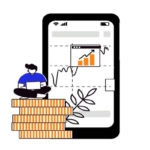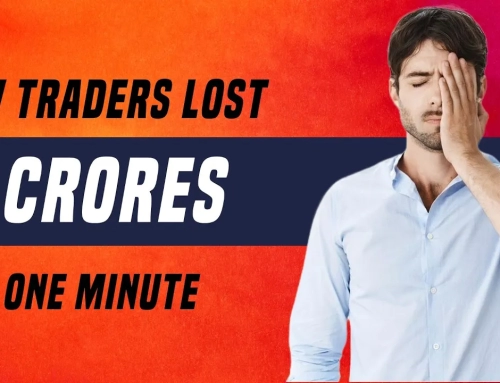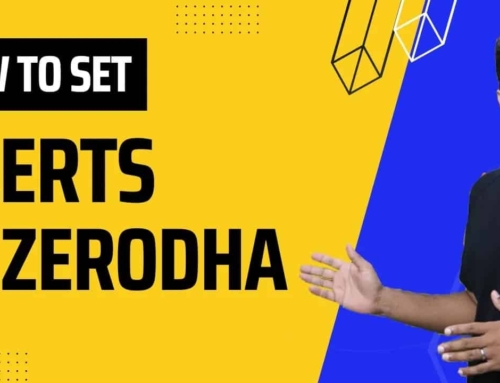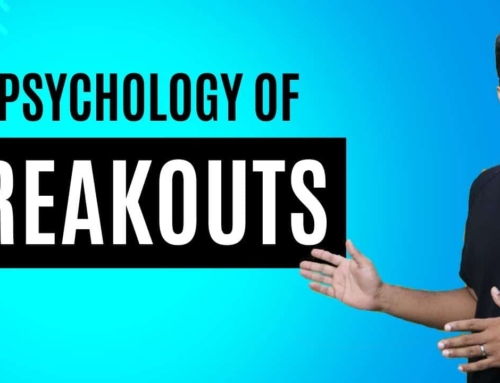How to Find Risk Reward Ratio for any Trade
So guys, welcome to VRD nation. This is the channel where we discuss every aspect of trading and investing using practical real-life examples. So if you are here for the first time, don’t forget to subscribe. So in today’s session, we will understand the easiest way to find out the risk-reward ratio of any trade.
It can be an intraday trade, a swing trade, a positional trade, a long or short trade and it doesn’t matter. We will see using trading views functionality, how easy it is to find out the risk-reward ratio of any potential trade. Now, for those of you who are new and may not necessarily understand the concept of risk-reward ratio, let me give a very quick introduction.
Risk is what you are willing to give. For any particular trade, whenever you’re taking a trade, there is no guarantee that the trade is going to work out. You need to know that, I’m taking this trade, but in case the state doesn’t work out, how much loss am I willing to take?
Risk is the amount that you are willing to give to the market to pursue that reward. Now, what is the reward? Well, the reward is what you hope to get. We take a practical example from today to illustrate the concept of risk and reward because these are not theoretical concepts. They are very important practical concepts in trading that you need to understand.
This is how the day has ended for me. So at the end of the day, this is what my reward is. But this reward did not come without any risk. All these 3 trades, which I took, had risks in each of them. You cannot make money in the stock market if you don’t know how to risk your capital. You have to take a risk if you want to make money.
Of course, all these 3 trades were doubtful and I made some money, but in case those trades would not have worked out, I would have incurred a loss. The loss that I would have incurred in those trades would have been my risk. So with the understanding of risk and the reward, let’s talk about the risk-reward ratio.
I will take the example of one of the trades which I took. So let’s say for one of those trades, my risk was 10,000 rupees and the reward that I was hoping to make in that particular trade was 20,000 rupees and the ratio of risk and reward typically, the way we do it is have your reward of 20k and divide that by the risk, which was 10 K here. So you got a reward to risk ratio of 2:1. The risk-reward ratio or reward to risk ratio tells us that how favorable is this trading opportunity for you. With that, I hope that you understood the concept of risk-reward.
Now, let me show you in trading view, how we can easily calculate the risk-reward ratio. So the first scenario that we would take is that a long trade where you’re buying first and selling later. So this right here is a daily chart of ITC. In ITC, you identify a crucial support level.
Let’s say that’s 200 rupees. You can see that ITC has found some Support. So every time ITC came back down and bounced back from 200 levels, it’s a very nice clean support at 200 rupees for ITC. So what you can say is that if I have to take a long trade on ITC, I will wait for ITC to come as close to 200 rupees as possible.
Then from here, I will initiate a long trade. This is how a long trade is planned and if I do initiate a long trade, the reward, in this case, will be 225 rupees, which was the recent high. So that can be your reward. So from here to here is your Reward and you are also very practical. You understand that not every trade would work out.
What if the support breaks on the downside and ITC starts to slide in that scenario? In that case, you have to cut your loss at some point. So you can say that I will exit ITC if it comes to 190, From here to here is your risk and of course, you will be taking a trade only if you see that the reward is bigger than the risk.
if you’re taking a risk of 20,000 rupees on the downside, you don’t want your reward to be 5,000 rupees or 3000 rupees. Since you are risking X amount, you want your reward to be higher than that. For finding out what your risk-reward ratio is for any trade, what you have to do is you have to go here and in the drawing tools and you will see that there are 2 options here, long position and short position.
What I will do is I will pick a long position in ITC at 200 rupees. So I’m going to click here and immediately you can see that there are 2 boxes here, one in the green color and the other in the red color, which is telling me the risk and the reward. So from here to here, what I see is that reward and from here to here, what I see is the risk. So what I can do is I can drag this little window and in this particular scenario, my target was somewhere around 225 rupees. So this high here, I can drag this guy up, and I will go up to here.
This is my reward and where is my risk? Well, my risk is up until 190, so I’m going to drag it all the way up to 190. This is the trade that I planned to take. So if ITC comes down here and I initiate a long position here, in that case from here to here is my reward. But in case ITC starts to crack below 200, then here to here is my risk. Now the beauty of this particular tool is that you don’t have to calculate the risk-reward ratio because you can see right here, it says risk-reward ratio. It’s 2.68 means for every 1 rupee that I’m risking in this trade, I stand to gain 2.68 rupees. You can do a right-click on this and you can go to the settings of this particular long position and you can specify.
In this particular case, my profit level target was 225, so I can make it 225 and my stop level was 190. I’m going to make it 190 here and now you can see very clearly. If you enter at 200 and you exit at 225, your target is 25 rupees up from here. If you stop this 10 rupees from here because from 200 to 190 is your risk.
How then would you calculate the risk-reward ratio in this case? Let us calculate the risk-reward ratio show here. So what is the reward here from here to here? 25 rupees is my reward and I’m going to divide that by my risk, which is from here to here and which is 10 rupees. From 200, 290, so 25 divided by 10, that is 2.5.
That ratio has already been given to us by trading view. This is one of the easiest ways of finding out the risk-reward ratio of any trade and it is very interactive. So you can just basically drag and drop and you can play around with it and you can also, of course, move your targets in any kind of trade, intraday or swing.
Now let’s take a scenario of a short trade where you sell first and buy later. This is a daily chart of HDFC bank and as you can see, HDFC bank has been struggling to make some new highs. Here HDFC bank is facing resistance at around 1632 rupees.
What you can see again, this is not a recommendation. I’m just giving an example. I still HDFC bank and bank nifty in general is very weak and I’m expecting, HDFC bank to go down and test maybe that 200 days moving average rate to somewhere around 1350.
You are thinking of taking a short trade on HDFC bank, but before taking a short trade, you need to make sure that the risk-reward is very favourable. In this case, what we can do is we can create a clone of this and we can see where the next support of HDFC Bank is.
This is where we are right now. If you initiate a short trade from here to here, this is going to be your reward. If HDFC bank goes down, you will make money and from here to here, it going to be your risk. Let’s see if the risk-reward is favorable in taking a short trade on HDFC bank.
For that, what we will do is we will come here and instead of taking a long position, we will take a short position. I’m going to click on short position and I will first click here and here and I can adjust a little bit. I can just kind of pull it down a little bit, at just some of the boundaries.
Here, what I see right now is the risk-reward ratio is 1.07, which is not very favorable. For making 10,000 rupees, for example, if I have to risk 10,000 rupees, it would not necessarily be a great trade. Maybe if HDFC bank gives me a little bit higher entry from here, then maybe the risk-reward will become better.
So what you can do is you can pull this guy up a little. And you can say that, if HDFC bank goes up to somewhere around 1557, in that case, the risk-reward ratio will become much, better for a short trade. I will wait for HDFC bank to go higher. This is the beauty of this tool that even before you take a trade, you can look at the risk-reward ratio, and then you can decide whether the trade is worth taking or not.
Now what I’ve explained to you so far is the basic concept of the risk-reward ratio. What you can also do in the settings is, you can play around with a lot of things here. For example, you can set, what is your account size tied to, in other words, what is going to be your traded amount? It can be 10 lakh or 5 Lakh rupees or you can mention the exact amount that you want.
You can also define the risk. What we were doing here, we were kind of dragging and dropping, but you can come here and you consider, my risk in terms of rupees, let’s say 25,000 or 10,000 or 5,000 rupees, you can adjust the entry price.
Instead of dragging and dropping here, this is my entry price rate. I find it much more convenient to just drag and drop rather than coming in, adjusting here. But you can do that either way. Profit level also, it’s easier for us to drag and drop. In this case, profit is here, you can drag and drop, uh, you know, the profit levels here.
They will automatically adjust, but if you want to go and be precise about it, you can go to the settings and you can change the price here. In this case, let’s say my price is 1300. So this is my profit target and it automatically came down. Now my stop, in this case, let’s say is a little smaller and let’s say 1600. I’m going to type it out and you will see the difference here. So I will press the button tab and you can see that the stop got adjusted. You can play around with this; profit level, stop level in terms of absolute price or their ticks and then you can also choose the colors.
You can just kind of play around with the colors. If you want to have a different color scheme here, you can do that. I like the compact stats mode because it directly tells me what the risk-reward ratio is. I don’t have to see everything, but if you want to see the details, you can just click on this.
This is what I wanted to show you guys that how can you see the risk-reward ratio of a long trade or a short trade on trading view, which by the way is a free feature. The same thing that you did here, you can also do in Zerodha because Zerodha also provides a trading view with charts.
So for example, on nifty today, I’m here on an intraday chart. For example, I’m just going to delete the volume chart here. You can click on this drawing toolbar and from here, you can click on the long position and the same functionality which we saw in trading view, You can see the functionality here.
So very, very easy. And you can also click on the settings button here and you can either make it compact. You can define your account size, your risk in terms of percentage. The same features that we saw in trading view are available in Zerodha as well because essentially the charts have been provided by trading view.
Now there is one last thing that I want you guys to think about and answer that question in the comments below. The risk-reward ratio need not always be favorable. So in the conventional understanding of trading, a reward should be bigger than the risk. Only then you want to put your money.
But in real life, you will see a lot of traders who take trades, where the reward is relatively smaller and the risk is higher, especially in option selling. So the question for you guys is if it is advisable to take a trade where the risk-reward ratio is not favourable. This is a thought experiment and I want to see how many of you guys will respond.
What I will do is I will answer 2 questions in the subsequent videos, but I hope that you would use the risk-reward ratio tool, which is available to us either through Zerodha or directly in trading view since this is a free feature and it’s a very powerful way of looking at your potential trades and deciding whether to take them or not.
Howdy!
If you’re here for the first time, let’s get introduced.
VRD Nation is India’s premier stock market training institute and we (Team VRD Nation) are passionate about teaching each and every aspect of investing and trading.
If you’re here for the first time, don’t forget to check out “Free Training” section where we have tons of free videos and articles to kick start your stock market journey.
Also, we got two awesome YouTube channels where you can continue the learning process.
Must-Read Articles
How to Find Risk Reward Ratio for any Trade
So guys, welcome to VRD nation. This is the channel where we discuss every aspect of trading and investing using practical real-life examples. So if you are here for the first time, don’t forget to subscribe. So in today’s session, we will understand the easiest way to find out the risk-reward ratio of any trade.
It can be an intraday trade, a swing trade, a positional trade, a long or short trade and it doesn’t matter. We will see using trading views functionality, how easy it is to find out the risk-reward ratio of any potential trade. Now, for those of you who are new and may not necessarily understand the concept of risk-reward ratio, let me give a very quick introduction.
Risk is what you are willing to give. For any particular trade, whenever you’re taking a trade, there is no guarantee that the trade is going to work out. You need to know that, I’m taking this trade, but in case the state doesn’t work out, how much loss am I willing to take?
Risk is the amount that you are willing to give to the market to pursue that reward. Now, what is the reward? Well, the reward is what you hope to get. We take a practical example from today to illustrate the concept of risk and reward because these are not theoretical concepts. They are very important practical concepts in trading that you need to understand.
This is how the day has ended for me. So at the end of the day, this is what my reward is. But this reward did not come without any risk. All these 3 trades, which I took, had risks in each of them. You cannot make money in the stock market if you don’t know how to risk your capital. You have to take a risk if you want to make money.
Of course, all these 3 trades were doubtful and I made some money, but in case those trades would not have worked out, I would have incurred a loss. The loss that I would have incurred in those trades would have been my risk. So with the understanding of risk and the reward, let’s talk about the risk-reward ratio.
I will take the example of one of the trades which I took. So let’s say for one of those trades, my risk was 10,000 rupees and the reward that I was hoping to make in that particular trade was 20,000 rupees and the ratio of risk and reward typically, the way we do it is have your reward of 20k and divide that by the risk, which was 10 K here. So you got a reward to risk ratio of 2:1. The risk-reward ratio or reward to risk ratio tells us that how favorable is this trading opportunity for you. With that, I hope that you understood the concept of risk-reward.
Now, let me show you in trading view, how we can easily calculate the risk-reward ratio. So the first scenario that we would take is that a long trade where you’re buying first and selling later. So this right here is a daily chart of ITC. In ITC, you identify a crucial support level.
Let’s say that’s 200 rupees. You can see that ITC has found some Support. So every time ITC came back down and bounced back from 200 levels, it’s a very nice clean support at 200 rupees for ITC. So what you can say is that if I have to take a long trade on ITC, I will wait for ITC to come as close to 200 rupees as possible.
Then from here, I will initiate a long trade. This is how a long trade is planned and if I do initiate a long trade, the reward, in this case, will be 225 rupees, which was the recent high. So that can be your reward. So from here to here is your Reward and you are also very practical. You understand that not every trade would work out.
What if the support breaks on the downside and ITC starts to slide in that scenario? In that case, you have to cut your loss at some point. So you can say that I will exit ITC if it comes to 190, From here to here is your risk and of course, you will be taking a trade only if you see that the reward is bigger than the risk.
if you’re taking a risk of 20,000 rupees on the downside, you don’t want your reward to be 5,000 rupees or 3000 rupees. Since you are risking X amount, you want your reward to be higher than that. For finding out what your risk-reward ratio is for any trade, what you have to do is you have to go here and in the drawing tools and you will see that there are 2 options here, long position and short position.
What I will do is I will pick a long position in ITC at 200 rupees. So I’m going to click here and immediately you can see that there are 2 boxes here, one in the green color and the other in the red color, which is telling me the risk and the reward. So from here to here, what I see is that reward and from here to here, what I see is the risk. So what I can do is I can drag this little window and in this particular scenario, my target was somewhere around 225 rupees. So this high here, I can drag this guy up, and I will go up to here.
This is my reward and where is my risk? Well, my risk is up until 190, so I’m going to drag it all the way up to 190. This is the trade that I planned to take. So if ITC comes down here and I initiate a long position here, in that case from here to here is my reward. But in case ITC starts to crack below 200, then here to here is my risk. Now the beauty of this particular tool is that you don’t have to calculate the risk-reward ratio because you can see right here, it says risk-reward ratio. It’s 2.68 means for every 1 rupee that I’m risking in this trade, I stand to gain 2.68 rupees. You can do a right-click on this and you can go to the settings of this particular long position and you can specify.
In this particular case, my profit level target was 225, so I can make it 225 and my stop level was 190. I’m going to make it 190 here and now you can see very clearly. If you enter at 200 and you exit at 225, your target is 25 rupees up from here. If you stop this 10 rupees from here because from 200 to 190 is your risk.
How then would you calculate the risk-reward ratio in this case? Let us calculate the risk-reward ratio show here. So what is the reward here from here to here? 25 rupees is my reward and I’m going to divide that by my risk, which is from here to here and which is 10 rupees. From 200, 290, so 25 divided by 10, that is 2.5.
That ratio has already been given to us by trading view. This is one of the easiest ways of finding out the risk-reward ratio of any trade and it is very interactive. So you can just basically drag and drop and you can play around with it and you can also, of course, move your targets in any kind of trade, intraday or swing.
Now let’s take a scenario of a short trade where you sell first and buy later. This is a daily chart of HDFC bank and as you can see, HDFC bank has been struggling to make some new highs. Here HDFC bank is facing resistance at around 1632 rupees.
What you can see again, this is not a recommendation. I’m just giving an example. I still HDFC bank and bank nifty in general is very weak and I’m expecting, HDFC bank to go down and test maybe that 200 days moving average rate to somewhere around 1350.
You are thinking of taking a short trade on HDFC bank, but before taking a short trade, you need to make sure that the risk-reward is very favourable. In this case, what we can do is we can create a clone of this and we can see where the next support of HDFC Bank is.
This is where we are right now. If you initiate a short trade from here to here, this is going to be your reward. If HDFC bank goes down, you will make money and from here to here, it going to be your risk. Let’s see if the risk-reward is favorable in taking a short trade on HDFC bank.
For that, what we will do is we will come here and instead of taking a long position, we will take a short position. I’m going to click on short position and I will first click here and here and I can adjust a little bit. I can just kind of pull it down a little bit, at just some of the boundaries.
Here, what I see right now is the risk-reward ratio is 1.07, which is not very favorable. For making 10,000 rupees, for example, if I have to risk 10,000 rupees, it would not necessarily be a great trade. Maybe if HDFC bank gives me a little bit higher entry from here, then maybe the risk-reward will become better.
So what you can do is you can pull this guy up a little. And you can say that, if HDFC bank goes up to somewhere around 1557, in that case, the risk-reward ratio will become much, better for a short trade. I will wait for HDFC bank to go higher. This is the beauty of this tool that even before you take a trade, you can look at the risk-reward ratio, and then you can decide whether the trade is worth taking or not.
Now what I’ve explained to you so far is the basic concept of the risk-reward ratio. What you can also do in the settings is, you can play around with a lot of things here. For example, you can set, what is your account size tied to, in other words, what is going to be your traded amount? It can be 10 lakh or 5 Lakh rupees or you can mention the exact amount that you want.
You can also define the risk. What we were doing here, we were kind of dragging and dropping, but you can come here and you consider, my risk in terms of rupees, let’s say 25,000 or 10,000 or 5,000 rupees, you can adjust the entry price.
Instead of dragging and dropping here, this is my entry price rate. I find it much more convenient to just drag and drop rather than coming in, adjusting here. But you can do that either way. Profit level also, it’s easier for us to drag and drop. In this case, profit is here, you can drag and drop, uh, you know, the profit levels here.
They will automatically adjust, but if you want to go and be precise about it, you can go to the settings and you can change the price here. In this case, let’s say my price is 1300. So this is my profit target and it automatically came down. Now my stop, in this case, let’s say is a little smaller and let’s say 1600. I’m going to type it out and you will see the difference here. So I will press the button tab and you can see that the stop got adjusted. You can play around with this; profit level, stop level in terms of absolute price or their ticks and then you can also choose the colors.
You can just kind of play around with the colors. If you want to have a different color scheme here, you can do that. I like the compact stats mode because it directly tells me what the risk-reward ratio is. I don’t have to see everything, but if you want to see the details, you can just click on this.
This is what I wanted to show you guys that how can you see the risk-reward ratio of a long trade or a short trade on trading view, which by the way is a free feature. The same thing that you did here, you can also do in Zerodha because Zerodha also provides a trading view with charts.
So for example, on nifty today, I’m here on an intraday chart. For example, I’m just going to delete the volume chart here. You can click on this drawing toolbar and from here, you can click on the long position and the same functionality which we saw in trading view, You can see the functionality here.
So very, very easy. And you can also click on the settings button here and you can either make it compact. You can define your account size, your risk in terms of percentage. The same features that we saw in trading view are available in Zerodha as well because essentially the charts have been provided by trading view.
Now there is one last thing that I want you guys to think about and answer that question in the comments below. The risk-reward ratio need not always be favorable. So in the conventional understanding of trading, a reward should be bigger than the risk. Only then you want to put your money.
But in real life, you will see a lot of traders who take trades, where the reward is relatively smaller and the risk is higher, especially in option selling. So the question for you guys is if it is advisable to take a trade where the risk-reward ratio is not favourable. This is a thought experiment and I want to see how many of you guys will respond.
What I will do is I will answer 2 questions in the subsequent videos, but I hope that you would use the risk-reward ratio tool, which is available to us either through Zerodha or directly in trading view since this is a free feature and it’s a very powerful way of looking at your potential trades and deciding whether to take them or not.















![What is Virtual Contract Note [Zerodha]](https://www.vrdnation.com/wp-content/uploads/2023/10/maxresdefault-virtual-note-500x383.jpg)



Leave A Comment